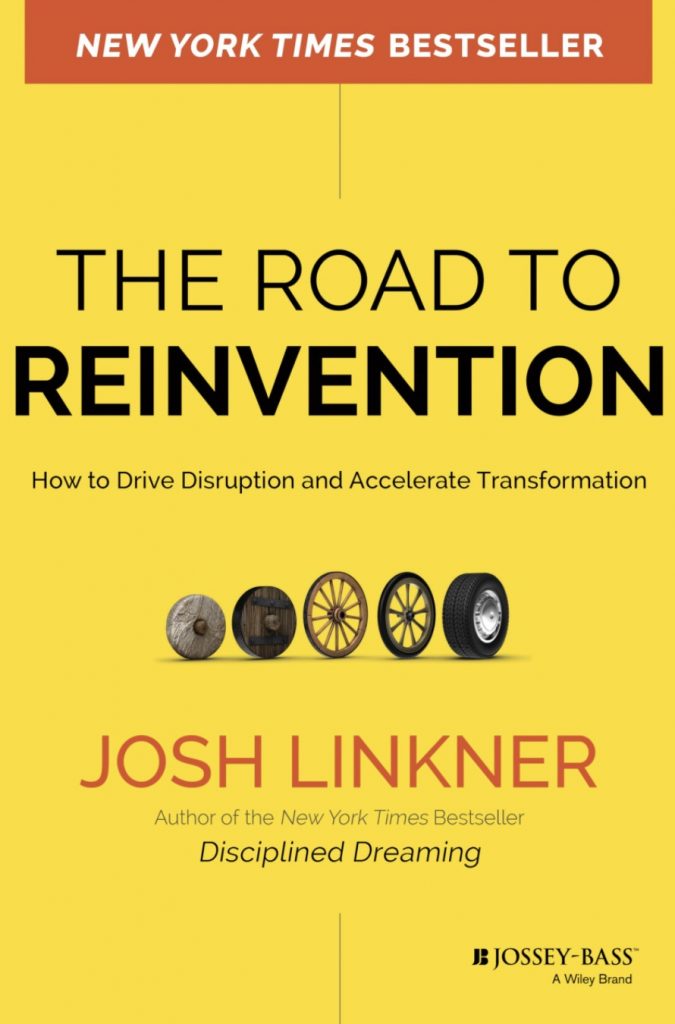Key Quote:
“BE true to your core beliefs, DO the things you care about, and the HAVE will take care of itself” (p. 198). — Josh Linkner
Key Points and Concepts
Disrupt or Be Disrupted
“Many organizations, once great, wither and die as a direct result of their deep entrenchment in the past. They discover too late that success isn’t about cracking the code once and then enjoying the spoils forever. Instead, it’s a moving target that we have to hit again and again” (p. 2).
Organizational decay may not be noticeable until it’s a problem. Trying to innovate and reinvent ata turnaround crisis point is too late. You have to do it while your business is healthy and strong.
Be a disruptor. “Disruptors challenge assumptions. They shake the status quo. They are curious and creative. They adapt and improvise.
They push the boundaries and shatter conventional wisdom. They’d rather forge new ground than blindly salute the flag of the past. Disruptors squirm at phrases such as ‘we’ve always done it that way,’ ‘that’s just the way things are done in our field,’ and ‘if it ain’t broke, don’t fix it’” (p. 22).
Embrace the Reinvention Ethos
There are eight principles that embody the disruptive mindset that can drive you and your business to success:
• Let go of the past— “The past is a great teacher, but it’s a horrible master” (p. 30).
• Encourage courage—Instead of chastising lousy ideas from your team members, question them and make them think through these ideas. After eight bad ideas in a row, they might have one that sparks a game changer, so make sure yours is an environment that encourages them to come forward (p. 33).
• Embrace failure— “The only truly nonproductive type of failure is the failure of courage we suffer when we’re afraid to explore new ideas” (p. 37).
• Do the opposite—Stand out from the crowd by taking the contrarian approach. “Instead of struggling to fight your way to the front of a stampeding herd, try turning the other way” (p. 38).
• Imagine the possibilities— “…you have to be willing to loosen your grip on the concrete realities of the here and now and venture into the unknown” (p. 39).
• Put yourself out of business—Embrace the “planned obsolescence” of software companies, who make their old version irrelevant with every release of a new version. Learn to kill your darlings (p. 40).
• Reject limits— “Great leaders put yes before no, can before can’t, will before won’t” (p. 44).
• Aim beyond— “…[the] development process needs to be targeted at where you think the market is heading, not myopically trained on ground that’s already been covered” (p. 45).
Keys to Reinvention
“Your responsibility as a leader is to deeply instill within your organization the understanding that even its most profound successes are only temporary delights” (p. 51).
Find the 10x factor—ask “Does this new solution solve a customer problem ten times better than the current market leader does?” and if it doesn’t go back to the drawing board (p. 64).
Linkner uses the metaphor of “clearing away cannonballs” as the way to begin the process of reinvention in your organization. A “cannonball” is “a system, process, or way of doing business that made all the sense in the world at one point but today is a relic, much like the US military’s requirement that three men are needed to fire a cannon, because when the requirement was written, a third man was needed to hold the horse’s reins (p. 77).
Linkner installed monitors throughout his company’s building to report key metrics in real-time, much like how a Jumbotron would for a sporting event, to ensure that everyone is focused and aware of the main issues (p. 123).
“Accept the death of one size fits all” (p. 152). Linkner encourages businesses to segment and appeal to niche markets, using permutations like gender, age, geography, and lifestyle to take a different or even sometimes polar opposite approach to how they have been providing their product or service.
Transform Your Career
Linkner provides different examples of self-reinvention:
• The Miles Davis— “Miles had an incredible gift for mastering a challenge, completely discarding it, and then moving on into the wide unknown. He is known for constantly forging new ground and reinventing his craft every few years rather than milking his previous successes” (p. 180).
• The Butterfly— Some people climb to new levels on paths that seem more traditional. They “start out in one state and naturally progress to a more advanced condition” (p. 180). This still requires a reinvention mindset to get the process in motion.
• The Bill Gates— “…changing to a completely different career with the specific goal of helping the world instead of enriching your bank account” (p. 183).
• The Curve Jump—This method of reinvention is defined by changing from one line of work to a radically different field, usually following a theme of opportunity rather than a specific craft (p. 186).
• The Passion Leap—Reinvent through following your passions—what you love to do and what ignites your energies. “Ditch the ‘ought to’ and ‘I’d better just’ and follow your heart instead” (p. 188).
• The Adventure—This method of personal reinvention bypasses “learning the ropes” and naïve imagination, and instead requires the determination and courage to disrupt the status quo from the start (p. 189).
Forge Your Legacy
“Many of us chase success, only to find it to be an elusive tease. We say to ourselves, if ‘I could HAVE what I want [money, fame, power, clothes, spouse, car, house], then I could DO the things I want, which would allow me to BE who I truly am’” (p. 198).
We think HAVE ≈ DO ≈ BE. Linkner argues that this is backwards and instead we should follow BE ≈ DO ≈ HAVE.
“BE true to your core beliefs, DO the things you care about, and the HAVE will take care of itself” (p. 198).
Expand your scorecard to measure intrinsic markers instead of just extrinsic markers of success. Think about things like: the number of times you bring joy to others each day, the amount of fear or sadness you’ve helped a friend overcome, the things you’ve created, etc. (p. 203).
Linkner, J. (2014). The Road to Reinvention: How to Drive Disruption and Accelerate Transformation. San Francisco: Josey-Bass.

“BE true to your core beliefs, DO the things you care about, and the HAVE will take care of itself.” (p. 198)
“Accept the death of one size fits all. Linkner encourages businesses to segment and appeal to niche markets, using permutations like gender, age, geography, and lifestyle to take a different or even sometimes polar opposite approach to how they have been providing their product or service.”
“Many of us chase success, only to find it to be an elusive tease. We say to ourselves, if ‘I could HAVE what I want [money, fame, power, clothes, spouse, car, house], then I could DO the things I want, which would allow me to BE who I truly am.” We think HAVE ≈ DO ≈ BE. Linkner argues that this is backwards and instead we should follow BE ≈ DO ≈ HAVE. “BE true to your core beliefs, DO the things you care about, and the HAVE will take care of itself.”
“Many of us chase success, only to find it to be an elusive tease. We say to ourselves, if ‘I could HAVE what I want [money, fame, power, clothes, spouse, car, house], then I could DO the things I want, which would allow me to BE who I truly am.”
